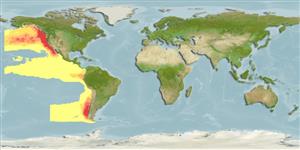Actinopterygii (ray-finned fishes) >
Lampriformes (Velifers, tube-eyes and ribbonfishes) >
Trachipteridae (Ribbonfishes)
Etymology: Trachipterus: Greek, trachys, -eia, -ys = rough + Greek, pteron = wing, fin (Ref. 45335); altivelis: From the Latin 'altus' meaning high and 'velum' meaning sail - referring to the high doral fin (Ref. 6885). More on author: Kner.
Environment / Climate / Range
Ecology
Marine; pelagic-oceanic; oceanodromous (Ref. 51243); depth range 0 - 900 m (Ref. 36610). Subtropical, preferred ?; 60°N -
Eastern Pacific: Alaska to Chile.
Size / Weight / Age
Maturity: Lm ? range ? - ? cm
Max length : 183 cm TL male/unsexed; (Ref. 2850)
Short description
Morphology | Morphometrics
Dorsal
spines
(total): 0;
Dorsal
soft rays
(total): 165-184;
Anal
spines: 0;
Anal
soft rays: 0;
Vertebrae: 90 - 94. First 5 rays of dorsal fin greatly elongated in young becoming reduced with age, otherwise rather higher in center, extending almost to caudal and ends abruptly (Ref. 6885); caudal fin highly asymmetric, dorsal lobe becomes well developed in juveniles with 7-8 rays directed upward at an angle of 45° to body axis, and eventually with growth is much reduced; ventral lobe elongate in young specimens becoming reduced to 5-6 spines directed backward from the caudal base in older individuals; anal fin absent; pectorals small, rounded; pelvic fins elongate in young and juveniles, reduced to base in larger individuals (Ref. 6885). Juveniles iridescent silvery with a series of about 4 dark blotches spaced above lateral line canal; upright and pelvic fins carmine red; larger individuals rather very silvery and greener with light spots, around scales; posterior end of dorsal fin darker (Ref. 6885).
Oceanic (Ref. 2850). Also found near shore, but large adults sometimes feed on the bottom (Ref. 2850). Small individuals feed on copepods, annelid worms, and fish larvae; larger individuals feed on copepods, euphausiids, small pelagic fishes, young rockfishes, squid, and Octopoda (Ref. 6885). Oviparous, with planktonic eggs and larvae (Ref. 36610).
Life cycle and mating behavior
Maturity | Reproduction | Spawning | Eggs | Fecundity | Larvae
Eschmeyer, W.N., E.S. Herald and H. Hammann, 1983. A field guide to Pacific coast fishes of North America. Boston (MA, USA): Houghton Mifflin Company. xii+336 p. (Ref. 2850)
IUCN Red List Status (Ref. 115185)
CITES (Ref. 94142)
Not Evaluated
Threat to humans
Harmless
Human uses
More information
Age/SizeGrowthLength-weightLength-lengthLength-frequenciesMorphometricsMorphologyLarvaeLarval dynamicsRecruitmentAbundance
ReferencesAquacultureAquaculture profileStrainsGeneticsAllele frequenciesHeritabilityDiseasesProcessingMass conversion
Tools
Special reports
Download XML
Internet sources
